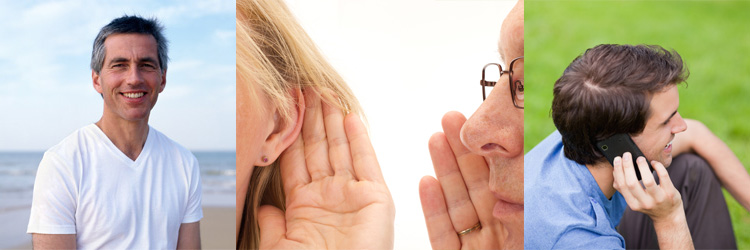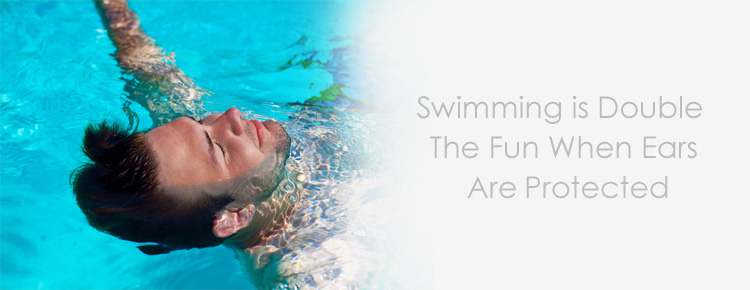How We Hear

How We Hear
Sound consists of vibrations of air in the form of waves. The ear is able to pick up these vibrations and convert them into electrical signals that are sent to the brain. In the brain, these signals are translated into meaningful information, such as language or music with qualities like volume and pitch. The volume of sound is measured in decibels (dB).
The ear consists of three parts: the outer ear, middle ear and inner ear. The outer ear is the visible part of the ear on either side of the head and includes the ear canals that go into the head. The fleshy parts of the outer ear act as “collectors” of sound waves, which then travel down the ear canal to the eardrum. This is a membrane of tissue that separates the outer ear from the middle ear.

The sound waves cause the eardrum to vibrate. This vibration is passed on to the middle ear, which consists of three small bones called the ossicles, which amplify and conduct the vibrations of the eardrum to the inner ear.
The inner ear consists of an organ called the cochlea, which is shaped like a snail’s shell. The cochlea contains tiny cells called hair cells, which move in response to the vibrations passed from the ossicles. Further amplification and modification occurs here. The movement of these hair cells generates an electrical signal that is transmitted to the brain through the auditory nerve.
Outer Ear
The outer ear is the most external portion of the ear. The outer ear includes the pinna (also called auricle), the ear canal, and the very most superficial layer of the ear drum (also called the tympanic membrane).
Middle Ear
The middle ear, an air-filled cavity behind the ear drum (tympanic membrane), includes the three ear bones or ossicles: the malleus (or hammer), incus (or anvil), and stapes (or stirrup). The opening of the Eustachian tube is also within the middle ear.
Inner Ear
Symptoms Of Hearing Loss

Symptoms Of Hearing Loss
People of all ages suffer from hearing loss. Most hearing loss occurs gradually, so the symptoms are difficult to recognise. It may begin by asking people to repeat themselves, or turning up the volume on the TV. As our hearing fades we tend to forget how things sound. Our world becomes quieter. We are unaware that we are missing the usual sounds of everyday life such as children laughing, birds singing and the sound of the sea.

If you, or someone you know, are experiencing one or more of the following problems it may be time to consider having a hearing assessment.
- People seem to be mumbling or don’t speak as clearly as they used to
- You have to strain to hear when someone talks or whispers
- You have difficulty hearing someone call from behind or in another room
- You need to watch a speaker’s lips more closely to follow conversation
- Following a conversation is difficult when you are in a group of people
- You have to turn up the volume on the TV or radio
- You have problems hearing clearly on the telephone
- You have difficulty hearing at the church, theatre, cinema or other venues
- You find it hard to hear in noisy restaurants or in the car
- You have begun to limit your social activities due to difficulty in hearing
- Family or friends mention that they often have to repeat themselves
Types of Hearing Loss

hearing loss. A third type is called mixed hearing loss and can be a combination of the other two types.

Conductive Hearing Loss
Conductive Hearing Loss is caused by anything that interferes with the transmission of sound from the outer to the inner ear.
Possible causes include:
- Middle ear infections (otitis media)
- Collection of fluid in the middle ear (“glue ear” in children)
- Blockage of the outer ear (by wax)
- Damage to the eardrum by infection or an injury
- Damage to the bones (ossicles) of the middle ear due to injury
- Otosclerosis, a condition in which the ossicles of the middle ear become immobile because of growth of the surrounding bone
- Rarely, rheumatoid arthritis affects the joints between the ossicles

Sensorineural hearing loss
is due to damage to the hair cells in the inner ear and/or to the pathway for sound impulses from the hair cells to the auditory nerve and the brain.
Possible causes include:
- Age-related hearing loss – the decline in hearing that many people experience as they get older
- Acoustic trauma (injury caused by loud noise) to the hair cells
- Head trauma
- Viral infections of the inner ear (may be caused by viruses such as mumps or measles)
- Ménière’s disease, which involves abnormal pressure in the inner ear
- Certain drugs, such as high doses of aspirin, quinine and some rarely used antibiotics, which can affect the hair cells
- Acoustic neuroma, a benign (non-cancerous) tumour affecting the auditory nerve
- Viral infections of the auditory nerve such as mumps and rubella
- Infections or inflammation of the brain or brain covering, e.g. meningitis
- Multiple sclerosis
- Brain tumour
- Stroke
- Other conditions such as diabetes, untreated high blood pressure, thyroid problems and many more.
Hearing loss can be congenital or acquired. A congenital hearing loss is when the hearing loss occurs before or just after birth. Exposure to certain diseases in utero or soon after birth can harm the hearing mechanism of a baby. Acquired hearing loss happens at a later stage and can be due to factors such as disease, noise or trauma to the head.
Preventing Hearing Loss

Hearing Protection
Prolonged exposure to noise will damage your hearing. Noise induced hearing loss is one of the most insidious attacks on our central nervous system. It can be seriously disabling.
The type of damage caused by loud sound is irreversible, permanent and unfortunately goes unnoticed until it is too late. There are a number of possible causes for hearing loss other than exposure to loud sound. However, hearing loss due to noise exposure is different in one way – it can be prevented or reduced. When you must be around noise, either at work or at play, use something to protect your hearing.
We fit a range of custom noise plugs including Elacin.

Custom Made
A comprehensive case history is taken, followed by a hearing assessment. We then take impressions of the ears, which is a painless process. Skilled technicians in the laboratory craft them and the result is custom-made earplugs. These reduce damaging frequencies whilst still allowing you to hear. A range of special filters reduces the levels by 9, 15 or 25 decibels. All the filters we supply conform to noise safety legislation. We also fit earplugs without filters, which further reduce noise. Custom-made electronic ear protectors are also available. Uses: Industry, Professional, Personal, Musicians, Motor sports, Motorcyclists and Shooting.

Swimming Ear Protection
Water can be problematic for some adults’ and children’s ears and aggravate an already existing condition. Customised swim plugs are available in a range of colours for those who need to keep their ears dry while swimming, showering or bathing. These swim plugs fit snugly in the ears and greatly reduce the risk of water getting into the ears. Please contact us for further information on these or any advice on hearing protection.

Loop System Venues
Loop Systems and Their Venues
A Hearing Loop is a loop of insulated wire fixed around a designated listening area which transmits a magnetic signal wirelessly around the loop. This signal is picked up directly, and without any interfering noises, by people with hearing aids if the hearing aid has a telecoil receiver fitted within it. Some hearing aids are so tiny that there is not room for a telecoil.
Loop systems can vary in size from a neck loop worn by someone at a conference – to large loops, which enable a hearing aid wearer to enjoy for example, a trip to the theatre because the auditorium is looped. In recent years these systems have become commonly available in public buildings such as cinemas, theatres, bank and post office counters, shops, bus and train stations and places of worship. When a loop has been installed, it is usually advertised either in the form of a written notice, or perhaps a sign such as this one, displayed in a prominent place.

To work with the hearing aid the telecoil is activated by a button on the aid. It can have up to two settings. One will allow you to hear only the sound from the speaker’s microphone while the other will allow you to hear the sound from the speaker’s microphone, the people around you and your own voice. Hearing aids which are compatible with a loop system, deliver sound that is customized by your hearing aids for your particular hearing loss. Additionally, the sound is contained in your ear/s, without bothering others. With some loop systems if you are bowing your head you may occasionally not hear as well. Remember to return your hearing aid to the normal setting when you are leaving the venue the loop is in, otherwise you will get interference in your hearing aid and you won’t hear well. If you are unsure as to whether you have a telecoil facility in your hearing aid/s or need any assistance with regards to the operation of your telecoil we will be pleased to assist you.
It is difficult to keep all the loop site listings up to date and we need your help to do so. If you have noticed any changes, omissions or errors in our listings that we need to update, please submit it to us at info@ferghac.ie and we will amend the changes as soon as we can. Thank you.
Co. Limerick Area
Churches
- Augustinian Church, O’ Connell St., Limerick
- Holy Rosary Church, Ennis Road, Limerick
- Redemptorists Fathers Alphonsus Street, Limerick
- St Josephs O Connell Ave. Limerick
- Christ the King Church in Caherdavin.
- St. Johns Cathedral, Limerick. (Only marked Seats left hand side near altar)
- St. Nessan’s Church, Raheen, Limerick
- Mary Magdalene Church, Monaleen, Limerick
- St.Andrew’s Church, Kilfinnane
- St. Mary’s Church, Askeaton
- St. Mary’s Church, Rathkeale
- Our Lady, Mother of the Church, Cahercolish (left hand side of church).
- Caherline Church
- St. Pauls Church, Dooradoyle
- St. Joseph’s Church, Kildimo
- St Joseph’s Church, Ballybrown
- St Josephs Church, Castleconnell
- Nicker Church, Pallasgreen, Co. Limerick. (Right hand side).
- Newcastlewest Church of Immaculate Conception. Right side of church.
- Athlaca Church St John’s
- St John The Baptist Nicker Church. (One side.)
- Church of Blessed Virgin Mary Patrickswell
- Dermot O Hurley Memorial Church, Caherline
- Cappagh Church, Co Limerick
- St Nicholas Boher Co Limerick
- Adare all seats except last four rows.
Other Venues
- Omniplex Cinema, Crescent Shopping Centre, Limerick
- Iarnrod Eireann Ticket Booth, Colbert Station, Limerick
- St.Camillus’ Nursing Home, Shelbourne Road (Day room only)
- Permanent Trustee Savings Bank Sarsfield Street, Limerick (First counter only)
- Dept of Social Protection, Dominic Street, Limerick, (Three Hatches)
- Limerick City Hall, Motor Taxation Department
- Green Hills Hotel, Ennis Road, Limerick, Rooms and Reception.
- Desmond Complex Film Club, Newcastlewest
- Revenue Commissioners, Charlotte Quay, Limerick
- Ulster Bank O Connell Street, Limerick
- Lime Tree Theatre, Mary Immaculate College, Limerick
Co. Clare Area
Churches
- St Joseph’s Church, Ennis Co.Clare
- Fransiscan Friary, Ennis Co.Clare
- St Flannan’s Cathedral, Ennis Co.Clare
- St. Patrick’s Church, Parteen, Co. Clare.
- Church of Ireland Cathedral, Killaloe
- Newmarket-on-Fergus Church, Newmarket-on-Fergus
- SS. John & Paul Church, Shannon
- Ballynacally Church, Clondegad,
- St. Senan’s Church, Kilrush
- SS Peter & Paul Church, Clarecastle
- Our Lady assumed into Heaven & St Senan’s, Kilkee
- Community Hospital Oratory Raheen, Toomgrainey.
- St Flannan’s Church, Whitegate
- Sacred Heart Church, Scarriff
Other Venues
- Shannon Airport specific areas indicated by drop down light. (public address)
- Glor Ennis
- AIB Newmarket-on- Fergus
- Cois na h-Abhaine, Ennis
Co. Tipperary Area
Churches
- Our Lady of the Wayside Church, Birdhill
- St. Mary of the Rosary Church, Nenagh
- St. John’s Church, Tyone Nenagh
- St. Mary’s Church of Ireland, Nenagh
- Our Lady & St. Lua Church, Ballina.
- Cathedral of the Assumption, Thurles
- Church of the Most Holy Redeemer, Newport
- St. Michael’s Church, Tipperary Town
- St. John the Baptist Church, Cashel
Other Venues
- Nenagh Motor Tax Office
Co. Galway Area
Churches
- St. Nicholas’ Cathedral, Galway (In one section near riverside)
- Franciscan Abbey, Francis Street, Galway
- St. Ignatius Jesuit Church, Spa Road, Galway
- Church of the Immaculate Conception, Oughterard
Other Venues
- Town Hall Theatre, Galway
Co. Kerry Area
Churches
- St. Bernard’s Church, Abbeydorney
- St. James’ Church, Killorglin
- St. John’s Church, Tralee
- St. Brendan’s Church, Tralee
- St. Mary’s Cathedral, Killarney
- St. John’s Church, Ballybunion
Other Venues
- Siamsa Tire Theatre, Tralee
- Listowel Post Office
- Allied Irish Banks, Listowel
- CYMS Hall, Killorglin
Co. Cork Area
Venues
- Cork Opera House
- Cork Co.Model Farm Road, Motor Tax Office
Co. Donegal Area
Churches
- Lough Derg Pilgrimage (Side aisle)
Co. Dublin Area
Venues
- LUAS Trains
- Grand Canal Theatre, Grand Canal Dock
- Helix Theatre, DCU
- Riverbank Arts Centre, Dublin
Request an Appointment

Opening Hours
We open every weekday from 9.00 - 5.00. We close for our lunch hour From 1-2. We are closed bank holidays, St Patrick's Day and Good Friday.
Monday - Friday: 9.00 - 5.00
Saturday - Sunday: Closed
Our Address
61 Catherine Street, Limerick
Phone: +353 (0) 061 313 633
Email: info@ferghac.ie
Web: http://www.ferghac.ie

